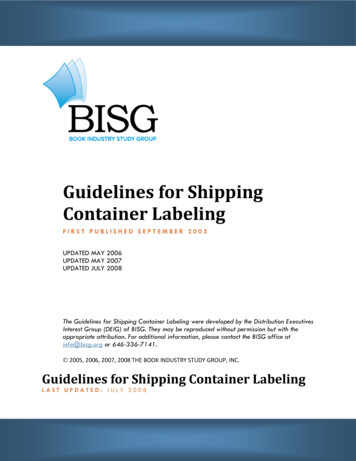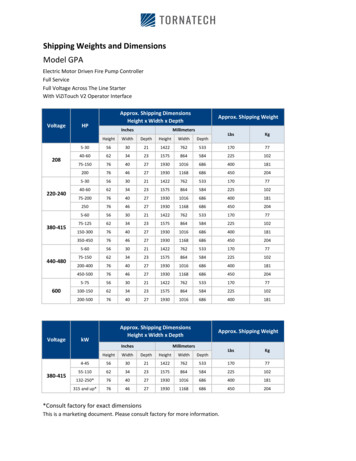
Transcription
HOW TO BUILD A SHIPPING CONTAINER HOUSE:PLAN DESIGN EXECUTE
PLANEstablish planning and design goals. Define and evaluate spacerequirements. Review benchmark standards, codes, and guidelines.
90% Of good architectural design is planning - knowing what you want from your home, what you canafford budget wise, and what the external factors (site, code, costs, etc.) are. Preparation is an important part of the designprocess. As you start to design your shipping container home, the "limitations" brought about by site, code, and budget can serveto inform many of the necessary design decisions along the way. Being aware of these issues and how they couldpotentially impact (productively or negatively) the design and budget, will keep the design economical and efficient. And buildable!This is a critical phase where expectations are set, and budget ceilings determined. The primary objective is to establish aconceptual design with input from design professionals, potential contractors, modular suppliers, and material/equipmentsuppliers. A comprehensive budget and schedule are also developed so a true profile of scope, budget and risk can beunderstood and assessed early on.I. BEFORE YOU STARTLook closely at shipping containers - photos, drawings, and if possible, go "tour" one. Walk around it. Standinside it. Getting a sense of the actual size 1:1 , is very helpful in understanding scale and working floor plans.
Know the relevant/binding codes you will have to contend with.Where you are planning tobuild your shipping container home dictates all requirements. Even if you are going to have a portion of thecontainer structural modifications done off-site at another location, it will be your local building/planningdepartment that will review drawings for conformance, issue permits, and conduct inspections. It is advisable tocontact your local building/planning department sooner than later. Dealing with building issues everyday, theycan be a great resource. You don't have to go into great detail about building with containers. Mention it, but inpassing. Focus the conversation on the fact that you are contemplating building a home with modular steelcomponents and are looking into pre-construction issues. Ask if there are any planning/zoning restrictions, amaximum square footage for any building(s), a maximum height limitation, or maximum number of bathrooms.Most building departments (even lots of smaller ones) have websites with all relevant code information aswell. At this point, don't get too intimidated by the code or scrutinize it. Concern yourself instead with big pictureissues. Like, canyou build a house(s) on the land/site, and what is the maximumsquare footage you can build. It is also important to get a list of what drawings, permits andinspections, including fees, will be required. Find out what drawings must be professionally stamped as well. Youshould also check if their are any deed restrictions on your title. Some jurisdictions dictate zoning and planningin deeds, especially subdivisions.It is worth mentioning here, that most states grant a land owner the defacto right to build a personal residenceon their private land, regardless of binding local zoning or building code. However, this is dependent onfinancing and post occupancy issues. If you are going to finance (mortgage) any of the cost of the build, bankswill require a certificate of occupancy (C of O). If you are planning on selling the land and house in the nearfuture, you will also need a C of O. This is to protect the future buyer. To get a C of O, you must conform thebuilding to all zoning and building codes.
Derive a rough order of magnitude project budget. Get the sticker shock out of the way at thebeginning. When you're building a house, you don't want costs appearing from nowhere. Unexpected expenses in both constructioncosts and professional fees, are typical. Even to the best prepared. The only way to minimize the unknowns is do yourhomework. Possible required professional services are land surveyor, civil engineer (storm water management, grading, septic),structural engineer, architect, and mechanical engineer. Permitting requirements are a good indicator here (see above). You mightalso contact local architects who have built conventional but comparably sized projects in your area. A quick preliminary conversationwith a good architect can give a sound picture of total soft costs. Also talk to potential contractors/builders, sub-contractors, andshipping container depots/resellers. Contractors can be an excellent source for pricing site portions of the project - includingfoundation, grading, bringing utilities to site, and septic. Researching/talking to shipping container depots can give a good sense ofcontainer prices and availability, but also local shop capabilities. It's good at this stage, to get a sense of what level of containermodification (and possibly interior fit-out) and at what cost can be done offsite. Welding on site, particularly on small projects, can bevery pricey. Having as much of the container modifications done offsite is a good initial general strategy.Without a building design , it's impossible to fill out the budget. Again, focus on the big picture. Goal is to have at least line items inyour budget for all potential costs (including both hard and soft costs). This will help tremendously as you begin to design and detailyour shipping container home. Our Project Budget Worksheet is a good reference and can help get you started with the budget. Linkto the worksheet is here. The budget will be a crucial document/resource throughout the process. Your project will be best served bycontinuous budget updates as you get more info and develop/focus the design.II. UNDERSTAND SITE ISSUES AND PASSIVE ENERGY POTENTIALSPassive vs. Active heating and cooling . At the risk of being too general, there are two types of buildingdesigns. Those that embrace the site, and those that impose themselves on the site. The house pictured below on the left isFrank Lloyd Wright's solar hemicycle Jacob's house. The house on the right is Mies van der Rohe's Farnsworth house. Both are icon's of20th century modern architecture built/designed by masters. They are both comparative in size, use, and initial project budget. Themaintenance and yearly energy expense for the two however, are substantially different. The contrast is due to the buildings' differentshapes, orientations, and wall/surface materials. The Jacob's house design embraces the site. Through the use of an earth berm andorienting the building to the path of the sun, the house advantages passive heating and cooling strategies. These help control temperatureand correlate to lower energy consumption. The Farnsworth house imposes itself on the site. Its orientation and open elevations create aseamless, transparent, and breathtaking flow of interior and exterior space.
However, it's a glass box that heats up quickly in the summer and is extremely drafty in the winter. Each building illustrates anextreme; the Jacob's house highly passive, the Farnsworth house requires substantially more active heating and cooling. Each hasits unique appeal and adaptability to container building and offer lessons to consider in the initial planning and conceiving of yourshipping container home design and site orientation.As we look closer at detailing and coreenvelope issues for a container house design in the PLAN section, we'll return to these two model houses and passive design.EMBRACEIMPOSE
Picking where to buildon site is a crucial decision. There aremany factors to consider including grade, soilbearing, existing landscaping, potential views,and proximity to easements/siteboundaries/roads. Generally speaking, if soilbearing capacity is consistent throughout thesite, flat/level areas are best suited. Theyrequire less grading/excavation, and allow forthe most economical foundation designs forshipping container homes. Landscaping andshading are very effective passive designstrategies. When you consider where to locateyour house/building on site try to takeadvantage of as much existing greenery aspossible.The location of dense, coniferous trees on the elevation against the prevailing wind (usually west or northwest) may decrease heatloss due to infiltration and wind chill factor in the winter. Sites with deciduous shade trees can reduce summer solar gain if positionedproperly on the south and west elevations of the buildings.Views and privacy will also be important things to consider. Every site is different and has its own potentials. If you don't alreadyhave a land survey of the site, it's probably a good time to get one done. They're full of relevant information and could bring things toyour attention (like easements and utility access locations) that you're unaware of. If you are lucky you received one when youpurchased the land or will be able to get one from the record files of your building department.
Time is the most important thing in life. Reviewing code and cold calling to get material pricing isn't the best time you'll ever have, evento the most enthusiastic home design/builders. But drawing yourandconceptual design,shipping container house floor planis where the good stuff starts. For real. Earlier, we said we were going to explore howdeveloping theshipping containers are a perfect fit for the design build process. The floor plan is a great example. The 8' width of a shipping containeris roughly a small room. Arrange two containers along their length, remove some corrugation, reinforce, and you've got a medium to largeroom. Remove all the interior corrugation, reinforce, and you have the equivalent of a New York City industrial loft. Containers are "designplaceholders" for the perimeter and interior of your home. They allow you to easily conceptualize the interior space and building massing,simultaneously.Buy a tape measure. Even if you have one. A new one. Make sure it has really good action. That it fits well in your hand, andcompliments your attire. It will be your new favorite accessory. Start measuring things. Everything. Measure rooms, furniture,circulation/open space. When you are thinking about dimensions of rooms for yournot sure what they should be, go measure a space that works and is comparable in size. Measure some more.shipping container floor plan andBefore you start drawing and sketching, make a wish list of all the functional elements. A schedule of all the square footage componentsincluding bedrooms, baths, kitchen, dining room, living spaces, garage, etc. Whatever that total square footage is, multiply it by a factorof 1.3-1.5 to add circulation/open space. Divide that by 320 and you know how many 40' containers to use. This is your startingpoint. Get some grid and trace paper. Floor plan software is readily available, but stick low tech for the conceptual sketches. A templatefile of containers and interior elements is available here to download. Templates like the "Twin 40' Container Layout" and "Typical InteriorDesign Elements" pictured above are in the sheets. They are all scaled equally so you can mix the interior elements with the containersand quickly work some simple floor plans. Houses and apartments in dense urban areas are very small. The average total floor area ina Japanese home is 1,020 square feet (three 40' containers). This should be an additive as well as a reductive process. You want to addto your wish list so you can incorporate/include as much as possible in your shipping container home, but you also want to edit. You cando a lot more with less spatially by introducing sunlight, compacting storage/service spaces, and combining/weaving together programelements. .
PLAN CHECKLIST: Review site and soil bearing capacity. Check for zoning restrictions. Determine maximum budget. Review site servicing requirements. Determine the binding code and review. Determine required professional services. Prepare project budget. Detail all program requirements - number of bedrooms, baths, home office, etcand determine rough square footage of each. Develop schematic design - including container massing configuration, floorplans, and elevations. Locate local or regional shipping container re-sellers and shops capable ofperforming modifications and interior fit-outs.
DESIGNDEVELOP YOUR DESIGN TO A LEVEL OF DETAIL NECESSARY TO WORK OUT ACLEAR, COORDINATED DESCRIPTION OF ALL ASPECTS OF THE PROJECT. DERIVEALL CONSTRUCTION, PERMITTING, AND BUILD DRAWINGS ANDDOCUMENTATION. DETERMINE FINAL BUDGET.
I. DESIGNING YOUR SHIPPING CONTAINER HOMEFoundationFinalize building location on site. Remember, flat sites are best as they require minimum excavation and grading. If you areplanning a build which consists of more than one container, you should talk with an engineer or contractor early. Foundationcosts are potentially very expensive, especially if the bearing capacity of the soil is poor or land substantially sloped.The three basic types of foundations are - full basement, crawl space, and slab-on-grade.Shipping Container Home Massing Examples
Shipping Container Home Floor Plans and InteriorsCommercial Office Container Floor PlanTotal Square Footage: 640 sfTwo 40' Shipping Containers
Core EnvelopeThe exterior walls, ground floor, roof, and glazing make up the core envelope of a building. Energy code compliance and yoursite's location, thermal zone, and climate factor strongly here and will determine insulation requirements. Keeping the buildingwarm in the winter and cool in the summer with minimal mechanical system help will do much to drive down monthly utilitycosts. The design section has information on passive vs. active heating and cooling strategies. These should be reviewed prior todeveloping/detailing the core envelope.
The US Department of Energy has a fantastic tool (REScheck) to simplify and clarify code compliance with the Model Energy Code(MEC), the International Energy Conservation Code (IECC), and a number of state codes. You input the square footage of each coreenvelope element (wall, roof, slab, etc.) and project location. This will determine the binding energy code and allow you to play withdifferent R values (insulation levels) until the envelope design is in compliance and thereby setting the required R-values. Even if yourproject is small or not subject to energy code compliance, the REScheck exercise is worth the time.The R-Value Table in the Reference Documents and Details section to the right that has different assembly R-values. Once you knowthe required R-values for the core envelope elements you can begin detailing. For illustration, consider a cold climate that requires anR-30 value for exterior walls. This could be achieve with batt (R 3.25 per inch R30 would require 9-10"), foam panels (R 5 per inch R30 would require 6"), and standard spray foam (R 6.75 per inch R30 would require 4.5").Plan and Section DetailsTypical Container Connection Plan Details
Utilities and MechanicalUtilites -Water supply andsewage, electricity, natural gas,and telecommunications/fiberoptics. Mechanical - Aircirculation and temperatureregulation.All these options must bethoroughly planned for, just aswith the build out of a typicalwood-frame home. There are noshort cuts and consulting with acontractor who specializes inthese fields is highlyrecommended.
II. DRAWINGS & DOCUMENTATIONThe drawings of a typical home construction project evolve through each of the design milestones - Conceptual/Scheme Design,Design Development, Permitting, and Bid/Construction Documents. Conceptual/Scheme Design and Design Developmentdrawings are important to develop the necessary design, floor plans, elevations, and the budget square footage takeoffs. Typically,they are a communication tool between the designer and client as they vet through the design of the home. If you are thedesigner, you will develop these drawings loosely yourself as you outline/document the design. You can use hand sketches orutilize one of the many consumer modeling and drafting applications. But, they are for your own reference and not necessary forfiling.Permitting DrawingsIf for what every reason you are not subject to any building department/jurisdictional approval (very rare) you will not need toassemble a Permitting Drawing set. If you are, which is most cases, first thing to do is call the building department and get apermitting submittal checklist. Things typically required will be plans (site, foundation, floors, and roof), elevations, land survey,water treatment (septic and run-off), energy code compliance, structural drawings, and soils report. Also make sure to check whichof these documents will need to be stamped by a licensed professional.Bid and Construction DrawingsContract Documents. They should include drawings and specifications for all components and systems of the building. A completeset of Contract Documents provides a comprehensive, fully coordinated set of construction documents and specifications that thecontractor uses to determine a guaranteed maximum or lump sum price, obtain necessary permits, coordinate with factory formodular components, and construct the project. Even if you are planning on taking on the construction yourself or managing theproject through sub-contractors, you should put together as detailed and extensive set of construction documents aspossible. Putting the construction documents together will help tremendously in understanding the design and verifying theprojected budget prior to construction.
III. BUILD STRATEGYRegardless if you are going to bid the project out to general contractors (GC) or build yourself, you should speak with as manypotential GC's as possible throughout the design process. Having done this prior to bidding the project will do three things; helpget accurate pricing for budget development, assemble a list of general contractors to bid competitively for the project (if you arenot building yourself), and problem solve the design.If you go the GC route, there are fundamentally three project delivery methods: Design/Bid/Build, Construction Management, andDesign/Build. The different methods are distinguished by the way the contracts between the Owner, the Architect (if there is one),and the Contractor/Factory are formed and the technical relationships that evolve between each party inside those contracts.Typically, there is no single "best" method for all projects, and no method delivers fastest, cheapest, and highest qualitysimultaneously. What distinguishes each is the amount of design information and drawings available prior to construction andwhether the build price is fixed or relative to actual costs.The design and manufacturing of shipping container homes is a viable alternative to conventional construction for manyreasons, but despite a strong showing of successful container projects, building with shipping containers is still in it's earlystages. From the design perspective, there are many design entities with "Kit" shipping container home offerings. Thesehowever, are very far from turnkey. Virtual none of the "design entities" have shop/manufacturing capabilities. The ones that do,have very small custom shops with limited output which is highly customized and high in price. From the manufacturingperspective, there are more and more factories/companies building with containers. Typically, they have a "stock" catalogue ofvery base shipping container home designs to purchase turnkey. Some can provide customized solutions (design to your specs),at higher cost points.Ultimately, whether to hire a general contractor or build yourself depends on - the complexity of the project, your skill and/orexperience in building, how much time you have to devote, expected level of finish or craftsmanship, and budget.
DESIGN CHECKLIST: Foundation Design Develop floor plans and elevations Determine Structural Design and Container Modification Requirements Envelope/Core Shell Detailing Figure out Energy consumption Investigate passive design moves to improve thermal performance Interior Fit-out development Prepare Mechanical and Electrical Design Outline Material Specifications Outline Lighting and IT Requirements Outline Build Strategy (think about whether you are going to act as general contractor or hire abuilder). Outline Procurement Strategy (what level of container modification and fit-out will be done atfactory and on site). Prepare Construction Documentation (both Architectural and Structural) Prepare Mechanical and Electrical Documentation Finalize structural design criteria Coordinate Preliminary Plan Review with building official Coordinate documentation for manufactured components Coordinate documentation for potential contractors Prepare final specifications Prepare final budget
EXECUTEBuilding a house is no small feet. Even a small one. There are thousands of materials, pieces, and tasksinvolved. Unless you are a builder or experienced it's intimidating. But, what containers as perfect modules allow youto do, is simplify the entire process. Think of a typical 1,000 square foot house. Try and work through in your head thetotal length of timber for the framing, square footage of sheathing, number of floor joists required, and ceiling rafters.Can't do it. Not too many can. Now think about that 1,000 square foot house made out of shipping containers. It's 3forty foot containers. By reducing the house into 3 base component pieces (modules), it's much easier to understand,design, and build.
I. PERMITTING, BIDDING, & PRE-ORDER Finish construction documents for your shipping container home and submit to building authority for permitting. Submit construction documents to factory for pricing and engineering of container modules. Clarifications to building authority and factory as required . Get required permits from building authority. Submittal of construction documents to general and sub contractors. Execute purchase order of container modules from factory.II. THE BUILDSite WorkBegin grading work including any requiredexcavation for foundation, utilities, stormwater management, and septic.Bring required utilities to site.Install septic system and any storm watermanagement system if required.
FoundationThe foundation shown below is a typical slab on grade application for a 1000sf (three 40' containers) shipping container homedesign. There is a 24' x 40' perimeter foundation wall made from precast concrete panels, but could easily be cmu block or pouredconcrete. The perimeter was excavated and trench filled with gravel (for drainage). The precast panels were dropped in via a craneand tied together. The panels included insulation and exterior water proofing membranes added at the factory. Utilities (water,electircal, and gas supply lines) are run to the base of the foundation and then to there respective locations in plan. Foundationwalls were then back-filled, soil compacted, gravel added, rebar laid out, and then slab poured.
Container ModificationsShipping containers have monocoque bodies. The corrugation panels (roof, sides, and back), floor, purlins, front doors, frame, andrails form an integrated structural skin. They are strong and made to carry floor loads far in excess of what is required for typical homeconstruction. But, when you modify them, cutting holes or penetrating members, they are weakened. Regardless of what level ofmodification your shipping container home design calls for, it is recommended to review with a structural engineer or architect.As we said above, when cutting a shipping container or removing any of the paneling, it's structural integrity is compromised.
As an extreme example, consider the removal of all a container's corrugated paneling along the length of one side (see the imagesbelow). Without reinforcement, the container deforms and then fails structurally. As a general rule, whenever you remove portionsof the panelized corrugation, steel framing will be required to frame out the opening. In addition, column and roof support will benecessary depending on the size of the opening(s) and roof/wind loads.Steel cutting, framing, and welding is a large part of shipping container home design and construction. Typically, steel constructionis not used much in single family or smaller home design because of expense. Cost of steel vs. wood/light guage framing issubstantial and the labor cost for steel vs. carpentry is also higher.To combat this, it is best to have as much of the welding and reinforcing done off-site before setting the containers on site andstarting the interior fit-out. Most (if not all) container re-sellers have the facilities to make these modifications. If you don'thave experience in metal work, or are not hiring a general contractor, you should plan on doing most of the container modificationwork off-site prior to delivery.
Most Containers are made of CorTenSteel. You should understand thequalities of this particular type ofsteel before considering the paintapplication for your finished product.CorTen develops a natural rustpatina to build a protective layeragainst erosion most paintproducts will not stop this process.
Set and Secure Containers to Foundation and Each OtherWhen the shipping containers arrive on site, they are crane-lifted one by one onto the foundation, hooked into place, and welded down tomarry them completely to the foundation. These heavy-gauge steel containers are so strong—each is designed to carry 57,000 pounds—thatthey need only be fastened at the corners to hold fast, much as they would be on a ship. In the example above, the shipping containerbottom corner blocks are welded to steel plates imbedded in the concrete slab to secure the house to the foundation. All corner blocks arewelded to each other to secure the containers to themselves in the image below.
Install windows, exterior doors, flashing, and any sky lights.Windows are set into openings that were measuredand cut prior to delivery of the shipping containers or roughed out on site. All openings for windows and doors should be framed with a steelsection. Hollow rectangle sections work the best, but an L section will work as well. Images below show openings for sliding door systems inthe end and sidewall panels of a container.
Install interior framing, insulation, heating and cooling systems, plumbing, electrical,and rough out all fixtures.Supertherm insulative coating, is sprayed on both sides of the remaining container walls. Supertherm is a high-performance, four-partceramic coating that carries an R value of R-19 and adheres to the steel surface of the shipping containers. A ½- inch plywood floor overthe existing ¾- inch plywood sub-floor is installed. Metal hat channels for wiring are run along the walls and vertical support beams aresecured. Metal studs and drywall are used for interior partition walls. Once insulated, the existing container walls are faced in drywall forfinishing.
III. INSPECTION & SIGN OFF Staged inspections through the build with contractor and building official - foundation, plumbing and electrical, architectural, and fire. Put together final check/punch list for contractor Review punch list with contractor Final inspection with building official for certificate of occupancy
EXAMPLE MODEL HOME DESIGN640 Square Foot Design
I. COMPONENT SQUARE FOOTAGE WORKSHEETEXAMPLE WORKSHEET OF MODEL HOME DESIGN WITH BREAKDOWN OF CONTAINERCOMPONENTS FOR PERLIMINARY BUDGET CALCULATIONS. THE 640 SF DESIGN SHOWN BELOWWILL SERVE AS THE BASIS FOR ALL WORKSHEET OUTLINES TO FOLLOW.
Perimeter/Core EnvelopePaneling vs Interior PanelingTotals**It is important to distinguish betweenperimeter (exterior) and interior panelingwhen budgeting.The exterior paneling will have a higherper surface area cost because it willinclude insulation and exterior finishtreatment.
Example Model Home Perimeter Paneling Surface Area (s.a.)And Interior Paneling Surface Areas (s.a.)
Panel Surface Area ReductionsNet paneling surface areas after reductions for interior space planningand exterior glazing
Glazing Surface Areas
Slab on Grade Foundation
to the most enthusiastic home design/builders.But drawing your shipping container house floor plan and developing the conceptual design , is where the good stuff starts. For real. Earlier, we said we were going to explore how shipping containers are a perfect fit for the design build process. The floor plan is a great example.










